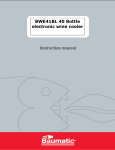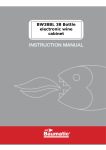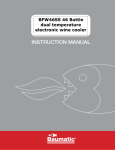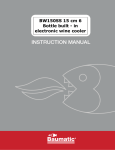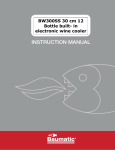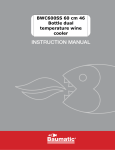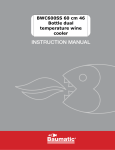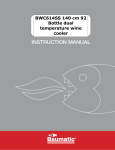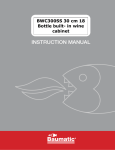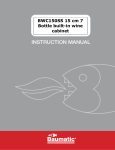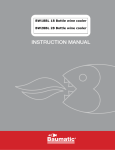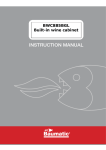Download Baumatic BWE41BL drink cooler
Transcript
BWE41BL 40 Bottle electronic wine cooler USER MANUAL FOR YOUR BAUMATIC BWE41BL 40 Bottle electronic wine cooler NOTE: This User Instruction Manual contains important information, including safety & installation points, which will enable you to get the most out of your appliance. Please keep it in a safe place so that it is easily available for future reference, for you or any person not familiar with the operation of the appliance. GS 10/05/10 2 Contents Environmental note 4 Important safety information 5–6 Specifications of your wine cooler Description of the appliance Control panel Description of the product features 7 8 9 9-10 Using your Baumatic wine cooler Before switching on During first use Switching on the appliance and setting the temperature Changing between Fahrenheit and Celsius Interior light Loading the wine cooler 11-15 11 11 12 12-13 13 13 Storing your wines Wine storage problems 13-14 15 Cleaning and maintenance Defrosting Reversing the door 16-18 17 17-18 Installation Electrical connection Positioning 18-20 19 19-20 Troubleshooting 21-22 Contact details 23 3 Environmental note Note: Before discarding an old appliance, switch off and disconnect it from the power supply. Cut off and render any plug useless. Cut the cable off directly behind the appliance to prevent misuse. This should be undertaken by a competent person. Disable the door lock to make sure that children cannot get stuck inside the appliance. o The packaging materials that Baumatic uses are environmentally friendly and can be recycled. o Please discard all packaging material with due regard for the environment. 4 Important safety information Your safety is of the utmost importance to Baumatic. Please make sure that you read this instruction booklet before attempting to install or use the appliance. If you are unsure of any of the information contained in this booklet, please contact the Baumatic Advice Line. IMPORTANT: Any installation work must be carried out by a qualified electrician or competent person. Use of the appliance o Your appliance is only designed to be used in the home. It is suitable for storing and chilling wine. NO food stuffs must be stored in the appliance. If it is used for any other purpose or it is not used correctly, then Baumatic Ltd. will accept no liability for any damage that is caused. o Altering the specification of the appliance must not be attempted for reasons of safety. Before using your appliance o Check the appliance for any signs of transport damage. If you notice any damage, then you should not connect your appliance to your mains supply and should contact your retailer. Refrigerant o Your appliance contains R600a refrigerant, which is a natural gas that does not contain CFCs that can damage the environment. However it is a flammable substance, therefore care should be taken: During the transportation and installation of the appliance, make sure that the refrigeration pipework does not get damaged. If it does become damaged then sources of ignition and open flames should be avoided. Also the room that the appliance is situated in should be thoroughly ventilated. o Do not place any objects on top of the appliance, as this may damage the table top. 5 Child safety o Packaging material should be kept away from children. o Children should not be allowed to touch the controls or play with the appliance. General safety o Do not pull on the power supply cable to remove the plug from your mains supply socket. o Do not pull out or insert the plug with wet hands. o Do not attempt to use your appliance outdoors or any place where it is likely to come into contact with the elements. o Before cleaning the appliance or performing maintenance work, ensure that the appliance has been disconnected from your mains supply. o Never allow the back coils of the appliance to come into contact with the wall surface. o Always ensure that the location where you are installing your appliance is free of stored items such as papers and other flammable materials. o Never block the ventilation openings of the appliance, either on the inside or its exterior. o It is vital to keep your appliance well ventilated, so that there is proper air flow between the bottom of the unit and the plinth/kick plate which it is sitting on. o Do not place electrical devices inside of the appliance, such as mixers or ice cream makers. Service You should not attempt to repair the appliance yourself, as this could cause injury or a more serious malfunction. If you require a service call then please contact the Baumatic Service Department. 6 Specifications of your wine cooler Congratulations on purchasing a Baumatic wine cooler o o o o o o o o o o o o o o o Gross capacity: 132 litres Net capacity: 126 litres Bottle capacity: 40 x 0.75 litre wine bottles Electronic control with LED display Tempered door glass Adjustable temperature Drain hose and auto-evaporated water tray Interior light 6 waved chrome shelves + 2 chrome racks Adjustable feet Reversible door Black door frame Black interior and exterior Smoke glass door Designed to store wine at its optimum temperature between + 7°C - 18°C Optional extra: BW40KIT- Wooden wine rack kit. Dimensions of appliance Height: Width: Depth: 842 mm 494 mm 545 mm * Please refer to the installation instructions for more specific information on the size of aperture that you will require. IMPORTANT: When you install your appliance it is important to bear in mind its climatic rating. In order to find out the climatic rating of your appliance, you should check the rating plate. The rating plate is located on the rear of the appliance. The rating plate will indicate the ambient temperature range that your appliance will function correctly within. It is also advisable to make a note of the model number and the serial number of the appliance before installing it. Model number ……………………………………………… Serial number ……………………………………………… Date of purchase …………………………………………….. 7 Description of the appliance 1) 2) 3) 4) 5) 6) 7) 8) 9) Control panel and LED display Cabinet Temperature sensor Adjustable feet Chrome racks Door seal Chrome shelves Door Interior light Please note that the above image shows the correct configuration of the shelving inside of the wine cooler. The image earlier in this manual does not show the correct configuration of the chrome racks. 8 Control panel The control panel is located at the top of the appliance, behind the glass door. A) Temperature increase button B) Temperature decrease button C) Light ON/OFF button D) Wine type indicator neons E) Temperature LED display F) Celsius/Fahrenheit indicator neons Description of the product features 1) Control panel o The control panel is located at the top of the appliance, behind the glass door. This means it is easy to set the temperature of the appliance and see what temperature the appliance is set to. 2) One cooling zone o There is one cooling zone inside of your wine cooler. o The cooling zone has a temperature control and temperature LED display. o The cooling zone can hold up to 40 x 0.75 litre wine bottles. o IMPORTANT: The temperature of the appliance will be warmer at the top of the cooling zone and cooler at the bottom. 9 o If you are trying to store a mixture of wine types in the appliance, we would recommend that red wines are stored at the top of the cooling zone, white wines in the middle of the cooling zone and sparkling wines at the bottom of the cooling zone. 3) Interior light o The cooling zone has an interior light. The light can be switched on and off by using the light ON/OFF button (C). 4) The wine cooler shelves o All of the full depth shelves have tabs that lock into both sides of the cabinet of the wine cooler. o Any of the shelves can be removed, to accommodate larger bottles of wine. Removing a shelf o Remove all of the bottles from the shelf that you want to remove. o Lift the shelf upwards and then gently pull the shelf away from the wine cooler. Replacing a shelf o Place the shelf back into a supporting guide slot and push it back until the shelf tabs slide into place. o IMPORTANT: You must not store any bottles on a shelf until the tabs are fully engaged. 5) Wine racks o There are additional wine racks at the bottom of the wine cooler. o The wine racks are removable for cleaning purposes. 10 Using your Baumatic wine cooler Before switching on o Make sure that it has been installed by a suitably qualified person, as per the information contained in Baumatic’s installation instructions. o After delivery, wait for eight hours before connecting the appliance to your mains supply. This will allow any refrigerant gasses that may have been disturbed during the transportation process to settle. o The outside of the appliance and the removable accessories contained within it, should be cleaned with a solution of liquid detergent and water. o The interior of the appliance should be cleaned with a solution of sodium bicarbonate dissolved in lukewarm water. The interior and accessories should be thoroughly dried, after the cleaning process has been completed. o There can be an odour when you first switch on the appliance. It will lessen as the appliance starts to cool. During first use o When you first switch on the appliance, the compressor will run continuously until the wine cooler reaches a cool enough temperature. o During this period of time, you should try not to open the door frequently or place bottles inside of the appliance. o If the unit is switched off or unplugged, you must allow at least 5 minutes before restarting the appliance or reconnecting it to your mains supply. 11 Switching on the appliance and setting the temperature o When the appliance is connected to your mains supply, the temperature LED display (E) will show the factory pre-set temperature of +12°C. o Use the temperature increase (A) and temperature decrease (B) buttons to set the temperature that you require. Each press of these buttons will adjust the temperature on the temperature LED display (E) by one degree. o Whilst you are setting the temperature of the cooling zone, the temperature LED display (E) will flash. When you stop pressing the temperature buttons, after 3 seconds the display will stop flashing and the temperature of the cooling zone will be set. o The temperature LED display (E) will show the temperature that is currently being registered by the cooling zone. Changing between Fahrenheit and Celsius o You can select whether the temperature LED display (E) shows Celsius or Fahrenheit. The Celsius/Fahrenheit indicator neons will light to show whether Celsius or Fahrenheit is currently shown. o To alter what the temperature LED display (D) is showing, press the temperature increase (A) and temperature decrease (B) buttons simultaneously. 12 o You cannot change the display if you are in the process of adjusting the temperature of the cooling zone (i.e. the display is flashing). Interior light o To operate the interior light, you should use the light ON/OFF button (C). You cannot operate the interior light if you are in the process of adjusting the temperature of a cooling zone (i.e. the displays are flashing). Loading the wine cooler o IMPORTANT: Your appliance is ideally suited to store 0.75 litre wine bottles. Whilst it can store larger bottles, you must make sure that they do not prevent the door from shutting properly. o Always check that you can close the door without it fouling on a wine bottle, before shutting it. o When loading several bottles of wine at once, it will take longer for the appliance to cool the individual bottles. Storing your wines The chart below indicates the ideal storage temperatures for different types of wine:Type of wine Red wine (*) White wine (**) Sparkling wines/champagne Rose wine Vintage wine Temperature (Celsius) 15.5 – 18.5°C 10 - 15°C 7.2 – 9.5°C Temperature (Fahrenheit) 59.9 – 65.3°F 50 – 59°F 45 – 49.1°F 9.5 – 10.5°C 13°C 49.1 – 50.9°F 55°F * Light red wines, such as Beaujolais, Pinot Noir and Cabernet Franc benefit from being served slightly cooler than full-bodied reds. ** Chardonnay is often served too cold. You should chill it at a warmer temperature inside of your wine cooler. Or leave it to warm slightly when you remove it from your wine cooler. 13 o Temperature stability is the most important factor when it comes to storing wine. o Exposure to light, vibrations or fluctuations in temperature and humidity can all cause wine to spoil. When properly stored, wines not only maintain their quality but many will actually improve in aroma, flavour and complexity as they mature. o Wines kept at a higher temperature will age faster. Wine that is exposed to temperatures that are greater than 21°C (70°F) will suffer from poorer flavour and aroma. o If wine is kept at too low a temperature, this can result in the development of harmful deposits. A humidity of 70% is ideal for keeping corks from shrinking. o After a bottle of wine has been opened, the wine comes into contact with air. So it is best to store the remainder of the bottle upright, to minimize the surface area of the wine that is coming into contact with the air. o Once opened, wine will remain in a drinkable condition for two days for delicate whites or three days for rich reds, as long as the bottle as been resealed. You should make sure that the seal is firm by checking the stopper. o Special stoppers that keep wine sparking and Champagne bubbling for one or two days after opening, can be bought at most good wine shops. o When stored correctly, white wines can keep well for up to two years. Full bodied reds will age well for ten years and dessert wines will age well for up to twenty years. o When you buy a bottle of wine, you should transfer it to a suitable storage location immediately (if you are not going to store it in your wine cooler). o Cheaper bottles of wine will not age as well as more expensive ones. o To make the most of the bouquet and taste of your wine, never fill more than half a glass at a time. It will also help if the shape of your wine glass is appropriate for your wine. The size and shape of your wine glass’s bowl will determine the intensity and complexity of the bouquet. The stem should be long enough to allow you to avoid hand contact with the bowl of the glass and should be tulip-shaped or tapered at the top. 14 Wine storage problems Corking- a tiny percentage of bottled wine (about 1%) will suffer from this. The cork reacts with the wine and gives it a musty, unpleasant taste. It is the most common wine storage problem and is caused by harmless bacteria growing on the cork. As unfortunate as this is, there is nothing to do but to discard all of the wine in the affected bottle. This is not to be confused with small fragments of cork floating in the wine itself, which will not impair the flavour. Oxidisation- when wine has been opened and left for longer than a day; it tends to lose its aroma and colour, giving an overall flat taste. The only way to avoid this, it to either drink the wine on the same day it was opened or to use a vacuum device specially designed for removing oxygen from opened wine bottles. If you use such a device, the wine should still be consumed shortly afterwards. Ullage- this is loss of wine from the bottle by evaporation or leakage. Signs of ullage include wine seeping around the cork, a protruding cork or a stained label. It can happen if the bottle has been allowed to get too warm. The wine may still be drinkable, if the leakage was recent; however, you should be aware that if the wine cools down again, contraction can cause more air to be sucked into the bottle and result in further deterioration. Slight effervescence in still wine- this isn’t really a problem with the way the wine has been stored, but as a result of incomplete malolactic fermentation before the wine was bottled. A good way to get rid of the effervescence is to let the wine breathe. Alternatively you can use a bottle vacuum device, after about five minutes the effervescence will vanish. Sediment- this is not normally a problem, however both red and white wines can produce sediment after a number of months in a bottle. The sediment consists of tartrate crystals and is totally harmless. If anything the building of sediment can be considered a good sign because it means that the wine was not subjected to much (if any) filtering, meaning that the flavours and aromas should be preserved better. A good way to get around sediment (if it is a problem) is to stand the bottle upright, the day before opening, so that the sediment can settle to the bottom of the bottle. You can also decant your wine; decanting will “open up” the flavour of both young and old wines, but younger wines in particular. To decant, pour the wine slowly and evenly into your decanter. 15 Cleaning and maintenance WARNING: PLEASE ENSURE THAT YOUR APPLIANCE IS DISCONNECTED FROM YOUR MAINS SUPPLY BEFORE ATTEMPTING TO CLEAN IT. o Do not clean the appliance by pouring water onto it or spraying water over it. o The interior of the wine cooler should be cleaned periodically, using a solution of bicarbonate of soda and lukewarm water. o Clean the accessories separately with soap and water. Do not clean them in a dishwasher. o Do not use abrasive products, detergents or soaps. o After washing the appliance, wipe over the area that you have cleaned with a damp cloth and then dry it thoroughly. o When cleaning is complete, dry your hands and then reconnect the plug to your mains supply. 16 Defrosting o Defrosting occurs automatically inside of the wine cooler during operation. The defrost water is collected by the evaporating tray and evaporates automatically. o The evaporating tray and defrost water drain hole should be cleaned periodically. This will prevent water from collecting in the bottom of the wine cooler, instead of flowing down the defrost drainage channel and drain hole. o You can also pour a small amount of water down the drain hole to clean inside of it. o You should be careful to make sure that wine bottles do not touch the rear wall of the appliance, as this can interrupt the automatic defrosting process and deflect water into the base of your wine cooler. Reversing the door Before reversing the door, switch off the appliance and disconnect it from the mains supply. o Place the wine cooler on its side, ensuring that it rests on a soft, smooth, non-damaging surface. 17 o Remove the upper hinge cover (1). o Use a screwdriver to remove the two screws (2) holding the upper hinge (3) to the right hand side of the housing. o Carefully lift up the door and place it on a soft surface to protect it from scratches. o Use a suitable pointed tool to remove the covers for the screw holes (12). o Pull out the two bolts (6) which hold the lower right hinge plate (10) in position. o Remove the bolt and the adjustable foot (5) on the left and fit them into the corresponding thread on the right. o Remove the hinge pin (11) and the adjustable foot (7) from the hinge plate (10) and replace them on the other side of the hinge plate (10). o Install the lower hinge plate (10) on the left. o Replace the door (turned through 180°) in its new position. Ensure that the hinge pin (11) is inserted into the guide hole on the lower part of the door. o Install the upper hinge (3) on the left hand side, using the screws (2). Ensure that the hinge pin is inserted into the guide hole on the upper part of the door. o Replace the screw hole covers (12) in the corresponding holes on the right. o Replace the hinge cover (1) on the upper hinge. Installation IMPORTANT: Before installation and usage read all the instructions and make sure that the voltage (V) and the frequency (Hz) indicated on the rating plate are exactly the same as the voltage and frequency in your home. The rating plate can be found on the front left edge of the inside of the wine cooler. The manufacturer declines all responsibility in the event of the installer failing to observe all the accident prevention regulations in force, 18 which are necessary for normal use and the regular operation of the electric system. Electrical connection YOUR WINE COOLER IS INTENDED FOR FITTED AND PERMANENT INSTALLATION. We recommend that the appliance is connected by a qualified electrician, who is a member of the N.I.C.E.I.C. and who will comply with the I.E.E. and local regulations. o Your wine cooler comes supplied with a 13 amp plug fitted. If in future you need to change the fuse in this plug, then a 13 amp ASTA approved (BS 1362) fuse must be used. o The wiring in the mains lead is coloured as follows: Brown Blue Green and yellow Live Neutral Earth o As the colours of the wires in the appliance’s mains lead may not correspond with the coloured markings identifying the terminals in your spur box, please proceed as follows: The brown wire must be connected to the terminal marked “L” (live), or coloured red. The blue wire must be connected to the terminal marked “N” (neutral), or coloured black. The green and yellow wire must be connected to the terminal marked “E” (earth), or by the earth symbol, or coloured green and yellow. o When the connection is completed, no stray strands or cut wire should be present. The cord clamp must be secured over the outer sheath. Positioning o It is advisable that your appliance is only installed in a location where the ambient temperature of the room, corresponds with the climate classification that is stated on the rating plate of your appliance. Your appliance may not function correctly if the ambient temperature falls outside of the following ranges. 19 Climate classification Appropriate ambient temperature SN +10 to +32 degrees centigrade N +16 to +32 degrees centigrade ST +18 to +38 degrees centigrade T +18 to +43 degrees centigrade o Positioning the appliance requires two people in order to avoid injuries or damage to the appliance. o Your appliance should not be located in direct sunlight or exposed to continuous heat or extremes of temperature (e.g. next to a radiator or boiler). If this is not feasible, then you should install an insulation plate between the appliance and the adjacent heat source. o You should check whether there is an electrical socket available, which will be accessible after your appliance is installed. o Place the appliance flatly and firmly on a solid base. The appliance is fitted with adjustable feet on the front side, which can be used to level the appliance. o Anything positioned above the appliance must be at least 20 cm away to allow sufficient cooling of the condenser. You must allow a 10 cm gap to the rear and either side of the appliance. o Be sure to leave enough space for the opening of the door, to avoid damage to the appliance or personal injury. o IMPORTANT: The vent at the base of the appliance is for ventilation. Nothing should be placed in front of this vent; otherwise your wine cooler may not operate properly. 20 Troubleshooting IMPORTANT: If your wine cooler appears not to be operating properly, before contacting the Baumatic Service Department, please refer to the checklist below. PROBLEM Appliance does not operate Temperature inside the appliance is too warm. Temperature inside the appliance is too cold Vibration Moisture is forming on the inside of the appliance. Moisture is forming on the outside of the appliance. Abnormal display on the control panel. POSSIBLE CAUSE Not plugged in. The circuit breaker has tripped or the fuse has blown. The temperature controls are set too warm. Set the temperature controls to a cooler setting and allow several hours for the temperature to stabilise. The door is being kept open too long or is being opened too frequently, which is allowing warm air to enter the appliance. The door is not closed completely. The door gasket is not sealing correctly. The appliance has recently been disconnected from the mains supply; it will take at least four hours for it to get down to temperature again. The temperature controls are set too cold. Set the temperature controls to a warmer setting and allow several hours for the temperature to stabilise. Check to ensure that the appliance is on a level surface. The appliance is touching the back wall behind it. Reposition the appliance and move it from the wall. If vibration continues to occur, then turn off the appliance and unplug it from your mains supply. Then contact the Baumatic Service Department for assistance. The door is slightly open. The door is being kept open too long or is being opened too frequently. Open the door less often. The door is not sealed properly. The door is slightly open, causing cold air from inside the appliance to meet warm, moist air from the outside. LL on the temperature LED display indicates that the temperature of the appliance is too low. You should use the temperature increase button (A) to adjust the temperature. HH on the temperature LED display indicates that the temperature of the appliance is set too high. You should use the temperature decrease button (B) to adjust the temperature. 21 F1 indicates that the thermostat is faulty. You should contact the Baumatic Service Department to arrange an engineer visit. IMPORTANT: If your appliance appears not to be operating correctly, then you should disconnect it from your mains supply and then contact the Baumatic Service Department on telephone number (0118) 933 6911. DO NOT ATTEMPT TO REPAIR THE APPLIANCE YOURSELF. Please note that if an engineer is asked to attend whilst the product is under guarantee and finds that the problem is not the result of an appliance fault, then you may be liable for the cost of the call out charge. The appliance must be accessible for the engineer to perform any necessary repair. If your appliance is installed in such a way that an engineer is concerned that damage will be caused to the appliance or your kitchen, then he will not complete a repair. This includes situations where appliances have been tiled in, sealed in with sealant, have wooden obstructions placed in front of the appliance, like plinths. Or any installation other than the one specified by Baumatic Ltd. has been completed. Please refer to the conditions of guarantee that appear on the warranty card that you receive with the appliance. 22 United Kingdom Baumatic Ltd., Baumatic Buildings, 6 Bennet Road, Reading, Berkshire RG2 0QX United Kingdom Sales Telephone (0118) 933 6900 Sales Fax (0118) 931 0035 Customer Care Telephone (0118) 933 6911 Customer Care Fax (0118) 986 9124 Spares Telephone (01235) 437244 Advice Line Telephone (0118) 933 6933 E-mail: [email protected] [email protected] [email protected] [email protected] Website: www.baumatic.co.uk Republic of Ireland Service Telephone 1-890 812 724 Spares Telephone 091 756 771 Czech Republic Baumatic CR spol s.r.o. Průmyslová zóna Sever 696 460 11 Liberec 11 Czech Republic +420 483 577 200 www.baumatic.cz Slovakia Baumatic Slovakia, s.r.o. Galvániho 7/D Slovakia +421 255 640 618 Germany Baumatic Gmbh Lilienthalstrasse 1 320 52 Herford Deutschland +49 5221 694 99-0 www.baumatic.de Italy Baumatic Italia S.R.L. Via Galvani N.3 35011 Campodarsego (PD) +3904 9920 2297 www.baumatic.it Holland Baumatic Benelux B.V. Grindzuigerstraat 22 1333 MS ALMERE Nederland +3136 549 1555 www.baumatic.nl 23 25 27 28




























